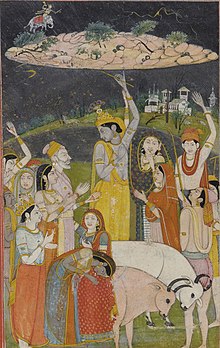Tags: Mobile edit Mobile web edit |
No edit summary Tags: Mobile edit Mobile web edit |
||
| Line 14: | Line 14: | ||
* [[Samba (Krishna's son)]] |
* [[Samba (Krishna's son)]] |
||
== |
==N |
||
{{reflist}}Rawat, Ramnarayan S. (2011). Reconsidering Untouchability: Chamars and Dalit History in North India. Indiana University Press. ISBN 9780253222626. |
|||
==References== |
==References== |
||
Revision as of 04:32, 27 October 2015

Yadu is one of the five Indo-Aryan tribes (panchajana, panchakrishtya or panchamanusha) mentioned in the Rig Veda.[1]
The Hindu epic Mahabharata, the Harivamsha and the Puranas mention Yadu as the eldest son of king Yayati and his queen Devayani. The prince of King Yayati, Yadu was a self-respecting and a very established ruler. According to the Vishnu Purana, the Bhagavata Purana and the Garuda Purana, Yadu had four sons, while according to the rest of the Puranas he had five sons.[2] The kings between Budha and Yayati were known as Somavanshi. According to a narrative found in the Mahabharata, and the Vishnu Purana, Yadu refused to exchange his years of youth with his father Yayati. So he was cursed by Yayati that none of Yadu's progeny shall possess the dominion under his father's command.[3] Thereby, he could not have carried on the same dynasty, called Somavamshi. Notably, the only remaining dynasty of King Puru was entitled to be known as Somavamshi. Thereby King Yadu ordered that the future generations of his would be known as Yadavas and the dynasty would be known as Yaduvanshi. The generations of Yadu had an unprecedented growth and got divided into two branches.
Descendants
King Sahasrajit's descendants were named after his grandson Haihaya and were well known as the Haihayas.[4] King Kroshtu's descendants had no special name, but were known particularly as the "Yadavas",[4] According to P.L. Bhargava, when the original territory was partitioned between Sahasrajit and Kroshta, the former received the part lying to the western bank of the river Sindhu and the latter received the territory situated along the east bank of the river.[5]
Several Chandravanshi castes and communities in modern India, such as the Sainis of Punjab Province,[6] Yadav,[7] ayar[8][9] Jadeja, Bhatti Rajputs,[10]Jadaun,[10] , Ahir[11][12][13][14] and jatav,claim descent from Yadu.
See also
==N
References
- Dictionary of Hindu Lore and Legend (ISBN 0-500-51088-1) by Anna Dhallapiccola
- Frawley David: The Rig Veda and the History of India, 2001.(Aditya Prakashan), ISBN 81-7742-039-9
- ^ Singh, Upinder (2008). A History of Ancient and Early Medieval India: From the Stone Age to the 12th Century. Delhi: Pearson Education. p. 187. ISBN 978-8-13171-120-0.
- ^ Patil, Devendrakumar Rajaram (1946). Cultural History from the Vāyu Purāna Issue 2 of Deccan College dissertation series, Poona Deccan College Post-graduate and Research Institute (India). Motilal Banarsidass Publisher. p. 10. Retrieved 23 September 2014.
- ^ Thapar, Romila (1996) [1978]. Ancient Indian Social History: Some Interpretations (Reprinted ed.). Orient Longman. pp. 268–269. ISBN 81-250-0808-X.
- ^ a b Pargiter, F.E. (1972). Ancient Indian Historical Tradition, Delhi: Motilal Banarsidass, p.87.
- ^ Misra, V.S. (2007). Ancient Indian Dynasties, Mumbai: Bharatiya Vidya Bhavan, ISBN 81-7276-413-8, pp.162-3
- ^ Singh, Kumar Suresh; Sharma, Madan Lal; Bhatia, A. K. (1994). People of India: Haryana. Manohar Publishers. p. 430.
- ^ Pinch, William R. (1996). Peasants and Monks in British India. University of California Press. p. 91. ISBN 978-0-52091-630-2. Retrieved 23 September 2014.
- ^ Temples of Kr̥ṣṇa in South India: History, Art, and Traditions in Tamilnāḍu by T. Padmaja p.34
- ^ Racial Synthesis in Hindu Culture by S.V. Viswanatha p.156
- ^ a b Barbara N. Ramusack (2003). The Indian Princes and their States, The New Cambridge History of India. Cambridge University Press. p. 24. ISBN 978-1-13944-908-3. Retrieved 23 September 2014.
- ^ K. S. Singh (1998). Rajasthan, Volume 1. Popular Prakashan. p. 44. ISBN 9788171547661.
- ^ Sandria B. Freitag (1992). Culture and Power in Banaras: Community, Performance, and Environment, 1800-1980. University of California Press. p. 136. ISBN 9780520080942.
- ^ S. D. S. Yadava (2006). Followers of Krishna: Yadavas of India. Lancer Publishers,. p. 10. ISBN 9788170622161.
{{cite book}}: CS1 maint: extra punctuation (link) - ^ Subodh Kapoor (2002). The Indian Encyclopaedia, Volume 1. Genesis Publishing Pvt Ltd,. p. 108. ISBN 9788177552577.
{{cite book}}: CS1 maint: extra punctuation (link)